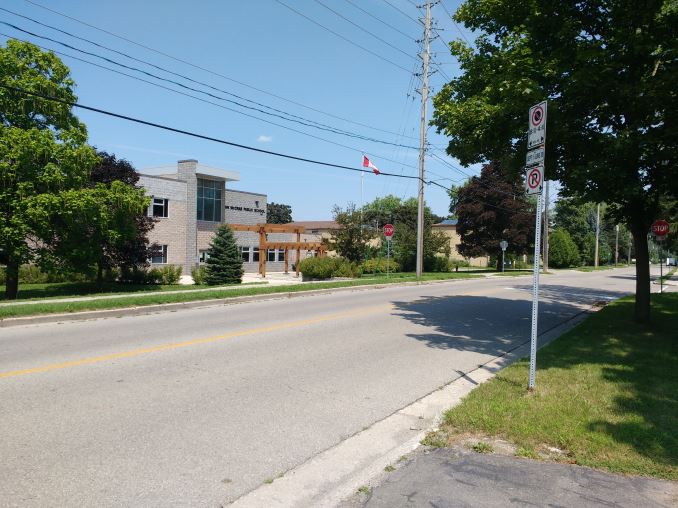The Moto G (2015) Review
by Brandon Chester on August 19, 2015 8:00 AM EST- Posted in
- Smartphones
- Mobile
Camera
One of the most notable improvements to the 2015 Moto G is its new rear-facing camera. The 2014 Moto G used Sony's IMX179, while the 2015 model adopts IMX214. The sensor size increases from 1/3.2" to 1/3.06" and the resolution increases from 8MP to 13MP. The aperture is also much wider, moving from F/2.4 to F/2.0, which can help offset the lower sensitivity of the smaller pixels. An overview of the Moto G's cameras can be found in the chart below.
| Camera Specifications | |||
| Moto G (2015) | |||
| Front Camera | 5MP (2560x1920) |
||
| Front Camera - Sensor | S5K5E2 (1.12 µm, 1/5") |
||
| Front Camera - Max Aperture | F/2.2 | ||
| Rear Camera | 13.0MP (4224x3400) |
||
| Rear Camera - Sensor | Sony IMX214 (1.12 µm, 1/3.06") |
||
| Rear Camera - Focal Length | 3.6mm (26mm eff) | ||
| Rear Camera - Max Aperture | F/2.0 | ||
While the Moto G lacks the voice coil motor from the Nexus 6 which is needed to enable OIS, the rest of the camera stack is effectively identical. The one difference on paper is the Moto G's shorter focal length which will give images a wider field of view.
Coincidentally, the move from IMX179 to IMX214 is the exact same change made between the Nexus 5 and Nexus 6. Whatever differences there are between the image quality of the 2015 Moto G and the Nexus 6 in good lighting rests primarily in the hands of their image signal processors. The Nexus 6 will obviously have a low light advantage due to its inclusion of OIS to lengthen shutter times, and we'll get to the low light differences after covering image quality with generous lighting.

In this daylight scene the Moto G performs very well. The exposure is very good, although I feel that it underexposed slightly while the Nexus 6 overexposed slightly. The Nexus 6 definitely has an edge when it comes to the sharpness of grass and foliage, as well as the preservation of textures such as the walls of the building and the pavement of the road. It's also worth noting that there's some lens distortion occurring on the Moto G which is causing color fringing along the white edges of the building windows, although at a normal viewing size it's barely noticeable. I think the Nexus 6 took an overall better photo, but only slightly better, with the Moto G doing a better job than any other mid-range device I've tested during the day.

Low light image quality is where things start to fall apart on the Moto G. While it's difficult to see in the small preview above, looking at the full size image reveals a great deal of color noise throughout the entire image, which doesn't exist on the Nexus 6. The Moto G took a 1/15s exposure, while the Nexus 6 was longer at 1/12s. 1/12s actually isn't very long for a device with OIS, and the difference in ISO value was not very large between the two devices either which means that Motorola's lacking quality has more to do with a simple lack of chroma noise reduction more than anything else. Chroma noise is by far the most distracting type of artifact in photos, and unfortunately it makes the Moto G unsuitable for photography in low light.
Video Quality
Video recording is a great test of a device's ISP as there's only a very short timespan to do processing on each frame that is captured. Since the 2015 Moto G and the Nexus 6 use the same image sensor this allows us to take a look at the differences in video quality between the ISPs in Snapdragon 410 and Snapdragon 805.
The Moto G records 1080p video at 30fps. Video is encoded with an average bitrate of 17Mbps using the H.264 high profile. For this comparison I limited the Nexus 6 to 1080p rather than UHD recording to make it an apples to apples comparison.
The most obvious advantage the Nexus 6 has is the stability of the video. While one might think this is due to the inclusion of OIS, the Nexus 6 isn't using the OIS for stabilization, and this is really just a case of superior EIS enabled by the superior ISP. As for the video quality itself, it's clear that the Nexus 6 is sharper across the frame and has greater detail on the various types of foliage in the area. The Nexus 6 also manages a better exposure, with the Moto G's video being too dark, with muted and just generally inaccurate colors. It appears that like the low light photo scene, the Moto G's video recording abilities are hampered by its ISP.
WiFi Performance
Like almost all of the low end and mid range devices I've tested recently, the Moto G ships with support for 802.11n on the 2.4GHz band. This single spatial stream implementation has a max link speed of 72Mbps.

The Moto G's WiFi speed is roughly the same as all other mid range devices. The Zenfone 2 is once again an exception to the rule, but I don't think anyone buying a device like the Moto G will have adopted an 802.11ac router at this point anyway due to cost reasons. I really hope we start seeing 5GHz support in mid range 802.11n phones though, rather than the ever increasingly crowded 2.4GHz band.






















90 Comments
View All Comments
shadarlo - Monday, August 24, 2015 - link
While the G2 is a great phone that I've had since nearly the launch, I am VERY ready for a new phone. I just don't see too many in this generation worth buying.For $175 or so that the G2 can be had for on sales it definitely blows away the current mid-tier phones.
phoenix_rizzen - Tuesday, August 25, 2015 - link
Except that managing iOS devices is a royal pain in the arse that requires bucketloads of money spent on software, hardware, and tech time. When a school district *needs* a full-time person (usually 2-3 if you want any kind of fast turn-around) doing nothing but managing iOS hardware and software, there's something wrong with the management tools. Apple Configurator is a joke. The MDM tools from various sources aren't much better. Any way you cut it, iOS device management is a time consuming money pit.Android management isn't much better, and the tools are very basic, but they are improving. The biggest problem is that what works for OEM X doesn't always work for OEM Y, and what works for Device A from OEM X doesn't always work for Device B from the same OEM. :( If you standardise on a single device from a single OEM, things aren't too bad.
Have no experience with BB10 or WinPhone management.
ChromeOS is really the only one that is easy to manage, even using the free tools from Google. As much as I dislike Chromebooks in general, the management tools are light-years ahead of anything available for the other mobile devices. (Unless you can afford 6-digit yearly licensing fees, in which case there's MDM software that comes close.)
Even with the horrible management tools, dealing with Android devices is still much better than dealing with iOS devices. We tolerate them on our networks; but we do everything we can to discourage people from buying them.
RaLX - Wednesday, August 19, 2015 - link
BTW, I would wait for the Nexus 5 before making any decision.mmrezaie - Wednesday, August 19, 2015 - link
Google usually messes the battery life so much. I bought the new moto e for the sole purpose of battery life, but it has some issues of its own.Pissedoffyouth - Wednesday, August 19, 2015 - link
No, installing crap like Greenify and things makes people whinge about battery life. Everyone who complains always runs these "battery saving 5000" apps and wonder why their phones are crap?Solandri - Wednesday, August 19, 2015 - link
The battery in my 2013 Nexus 5 began dying prematurely. It'd start off the day at 100%, get to 50% by around 3pm, then it'd go from 50% to dead in the next hour. Google eventually replaced it with a new phone under warranty. But as part of the troubleshooting process, they asked me to do a rundown test with the phone in safe mode. Safe mode disables all apps and services which weren't installed on the phone by default. All the default functions (phone, camera, etc) still work.The damn thing lasted just shy of 3 days even with a bad battery. It's made me seriously reconsider what apps I install on my phone.
eek2121 - Thursday, August 20, 2015 - link
Get an HTC One M8. Install CM12.1 on it. Even on stock I was getting 24 hours on a charge, and i'm a heavy user, browsing the internet for hours every day. Love this phone.Devo2007 - Sunday, August 23, 2015 - link
I've always wondered what effect Greenify, Amplify, etc really have on battery life. Sure, sometimes random wakelocks can impact battery life, but unless someone is specifically seeing something draining the battery if makes me wonder if these apps do more harm than good.Devo2007 - Sunday, August 23, 2015 - link
... Of course, the moment I express concerns like this, I usually tend to get shot down pretty quickly as someone who has no idea what I'm talking aboutmmrezaie - Wednesday, August 19, 2015 - link
I meant for Nexus phones.